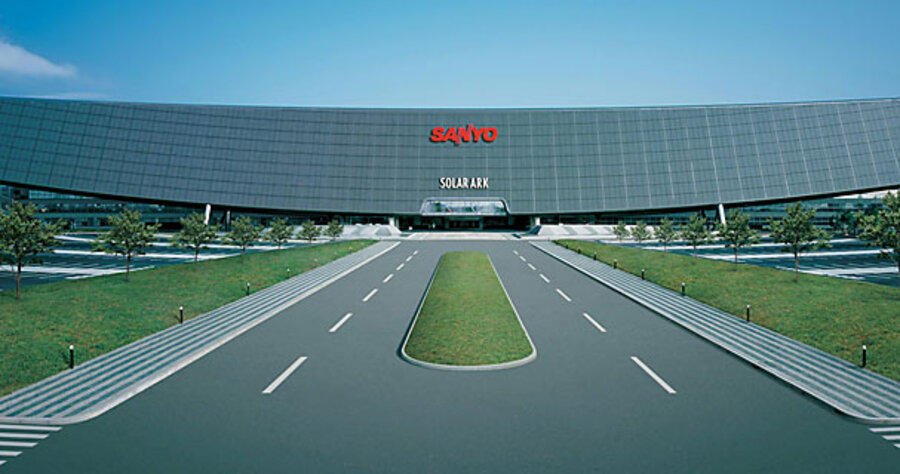Green architecture’s new goal: stylish sustainability
Loading...
If you’re one of many who identify “green” buildings as an ecological necessity but as an aesthetic blight, you’re hardly alone. Architect Rebecca Henn, a juror in this year’s American Institute of Architecture competition for top environmental designs, noted, “The big box store that could have been an exemplar of sustainability was, frankly, really ugly.... If we don’t hold beauty and sustainability as equal cultural commitments, then we might as well hand over our licenses and call ourselves aesthetic consultants.”
Architect James Wines, author of “Green Architecture,” also cuts to the chase: “[W]ith-out art, the whole idea of sustainability fails. People will never want to keep an aesthetically inferior building around, no matter how well stocked it is with cutting-edge thermal glass, photovoltaic cells, and zero-emissions carpeting.”
Whatever their aesthetics, the number of sustainable buildings has grown exponentially, according to the US Green Building Council, an educational clearinghouse and certification agency for such projects. The United States market in green-building products and services has soared from more than $7 billion in 2005 to more than $12 billion today, the council reports. So, ready or not, expect to see sustainable buildings wherever you reside.
And that raises the question: How can architecture most effectively offer us the beauty we crave in our everyday lives – while being protective of the environment? Global warming is catalyzed by greenhouse gases, nearly half of which are generated by creating and maintaining architecture. Given that reality, it might seem downright superficial to care about whether our buildings can be beautiful.
As journalist Virginia Postrel insists in her book, “The Substance of Style: How How the Rise of Aesthetic Value Is Remaking Commerce, Culture & Consciousness,” “We want styling, decoration, adornment” – but not at the price of a loss of utility or ecological disaster.
The cliché of ugly green architecture contains, like many old clichés, a seed of truth. Among sustainable designs that many have found abhorrent artistically:
• Industrial shipping containers starkly stacked in a Mondrian-like maze with minimal ornamentation. An official from ISBU (Intermodal Steel Building Units & Container Homes) wrote in a design blog, “We find the general public love the idea of an easy-to-use cube. They love putting many together to create a normal-size home. But they don’t want a home that looks like a shipping container.”
• Building exteriors highlighting extreme, rough-hewn surfaces that suggest neoprimitive cave or mud dwellings, or high-tech buildings with sci-fi-scaled jutting rooftop solar collectors. The Los Gatos, Calif., town council has denied homeowners solar-power systems that aren’t the same pitch as the roof and insist that they should be hidden from view.
• Structures imitating animal or geological forms that are aesthetically at odds with conventionally designed architecture in the area. You might speculate that only a building’s owner would care deeply about whether the surfaces of the building are artfully pleasing. Guess again. In architecture, a successful project entails a careful coordination of architects and engineers and construction workers. An improperly installed living-room window in a home might look odd, creating a mild cosmetic blemish – but worse, an associated heating and cooling loss might arise. And a wall’s durability could be affected by the improper installation. Buildings are like houses of cards; a mishap by one subcontractor that looks like a surface scar might seriously weaken a crucial subsystem, or a whole structure.
“One of the more challenging aspects of sustainable design is integrating emerging green technologies within mission-critical facilities, such as a research lab or acute-care hospital ward,” remarks David Gibney, Western regional director for HDR Sustainable Design Solutions.
“Designers and facility owners are rightfully reluctant to incorporate new building technologies.... If you make it past that hurdle then there is the added time for new design and construction techniques. So, as sustainable champions we find ourselves being researcher, salesman, and coach all at the same time.”
A beautiful green building requires a team effort to juggle the potentially conflicting values of utility, beauty, cost, durability, and sustainability. In a perfect world where the building owner has buckets of money, these values might only minimally clash, and the trade-offs between sustainability and aesthetics might be minor. For example, if you have enough money to install a hardwood floor for your home, you can use a green material such as bamboo (which takes seven years to mature compared with oak’s 120 years). But like other ecofriendly materials that possess an exotic beauty, the best ecological choice may well be costlier than the more commonly used oak.
Yet there are innovative designs for both residential and commercial use that offer inspiring lessons in how to approximate the best of both worlds. In the residential realm:
• Architect and educator Robert Barnstone has created a “quilted” sculptor’s studio-living space in British Columbia. The building’s patchwork patterns handsomely integrate recycled materials (including glass-door fronts from old Herman Miller furniture) with new cedar.
• A Hopi Nation elder home was constructed in Hotevilla, Ariz., utilizing straw-bale construction. For centuries, the Hopi used straw for the roofs of their houses of religious ritual. Repurposed straw carries the symbolic energy of a vibrant historical and cultural connection.
And in shifting focus to the high-tech and commercial architectural realm:
• The Sanyo Corporation has built a solar energy interactive museum within a massive solar power plant equaling the output of many fossil-fuel plants. More bracing is that this striking, industrial-strength ark sculpture is composed of thousands of factory-recalled solar cells recycled and repaired from Sanyo’s junk piles – a rare fusion of budgetary restraint, ecological awareness, and aesthetic museum design.
What these examples share is a repurposing of ancient symbolic forms – quilt, straw roof, ark – blurring stylistic distinctions between folk and professional design, between low and high technology. To paraphrase the English poet John Keats, if architectural truth is beautiful, these alluring creations are the true soul and substance of artful sustainable architecture.





